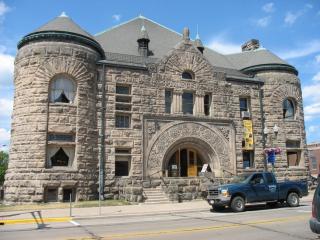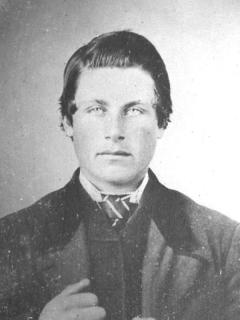Mabel Tainter

The Lumber Baron, the Feminist, and the Agnostic Minister
The Mabel Tainter Center for the Arts stands on East Main Street in Menomonie, Wisconsin. Built in 1889 to house a humanist Unitarian congregation, to provide a performance space for theater and music, and to serve the community in other ways, it is now a historic site that serves similar purposes.
It is also a monument to the vitality of the Western Unitarian Conference and to the three people in Menomonie who were responsible for its creation.
The Lumber Baron
Andrew Tainter (1823-1899) was an unlikely Unitarian. Known socially as Captain Tainter because of a few years when he ran steamboats on the Red Cedar River, he was mainly a lumber man. Muscular and adventurous, he made his fortune by felling thousands of acres of Wisconsin white pine and floating the logs to market

Andrew Tainter
He was a rugged character with an enlightened side. While he had little education and his English was crude, he also spoke French and Ojibwa, the languages of his lumberjacks. The Ojibwa respected him, no doubt in part because one of their people, Mary Poskin, was his wife.
Andrew soon became the backbone of the Knapp Stout Lumber Company, though at a cost to his family life. As his business grew, he pressed Mary to move the family from the remote lumber camp to Menomonie. She resisted, feeling (doubtless with reason) that the whites in town would not respect her. At one point during Andrew’s absence, the Ojibwa community moved to Lac Courte Oreilles. Mary went with her people and took the four children. Though pregnant, she felt the nine-year marriage was finished. When Andrew found her, he forcibly took the children, including the newborn infant, devastating Mary emotionally and angering the Ojibwa community. He believed the children had better prospects for education and health living with him in town.

Bertha Lucas Lesure
The Feminist
To care for his children, in 1859 Andrew hired Bertha Lucas Lesure (1828-1916), who had two children of her own by a long-absent husband. Bertha knew Andrew’s rough reputation, but she also saw good qualities in him and was strongly drawn to the children. In 1861 they married. Bertha’s husband had been gone long enough to be regarded as legally dead, and Andrew’s union with Mary had never been formalized.
The blended family was increased by five children borne by Bertha. Disregarding the racial attitudes of the day, the Tainters treated Mary’s children as equals with Bertha’s. Those who died were buried in the same family plot regardless of who their mother was.
Bertha had formidable strength of intellect and will. She read extensively in medical journals and practiced as a healer. Interested in Transcendentalism, she founded Menomonie’s Emerson Society. And she was notably willing to flout convention when necessary to promote her views. Known as a suffragist, she was also concerned for racial justice. After the Civil War, she delivered a public address in favor of the Freedmen’s Bureau, a government agency that aided former slaves. It was considered unfeminine in those days for a woman to address a male audience, especially if, like Bertha, she was visibly pregnant—with twins.

Mabel Tainter
One of the twins, Ruth, died in early childhood. The other lived longer. Mabel Tainter was a studious, thoughtful girl who loved literature and the performing arts. In June of 1886 she began undergoing severe abdominal pain, possibly from appendicitis, for which surgery was still in development. After a week she died, aged nineteen.
The Agnostic Minister
The Reverend Henry Doty Maxson (1852-1891) had planned early in life to be a minister in the Seventh Day Baptist denomination, but because of his growing doubts he chose instead to teach school. Discovering Western Conference Unitarianism enabled him to return to ministry. He was an esteemed friend of Jenkin Lloyd Jones and Jones’ fellow humanist James Vila Blake. Many in Menomonie and Eau Claire called him warmhearted, good-humored, learned, witty, even Christlike. He called himself agnostic.

Rev. Henry Doty Maxson
When the Menomonie Unitarian Society, which had developed from Bertha’s Emerson Society, sent out a call for ministry candidates, Maxson responded. His candidacy sermon, “Religious Possibilities of Agnosticism,” used texts from Thomas Henry Huxley and Matthew Arnold. This passage gives its flavor:
“In the nineteenth century, we have learned that the speediest way to drive pestilence from a crowded town is to give more careful attention to drainage and the water supply. Prayer has been replaced by sanitation; typhus is exorcised by cleanliness instead of genuflections. Religion . . . has retired from before the face of knowledge.”
He went on to say that religion was still necessary because of the mysteries of which expanding knowledge made us aware. Andrew Tainter, who had rejected his father’s strict evangelical beliefs and was normally averse to churchgoing, listened attentively and then voted to call Maxson.
After Mabel’s death, Andrew and Bertha decided to build a place of worship in her memory. Maxson recommended that the Mabel Tainter Memorial serve multiple community functions, the common practice in the Western Unitarian Conference. Accordingly, it included a combined performance and worship space (below), the town’s first city hall, a public library, and meeting rooms.

Maxson served the congregation with talent and energy. He also held office in the Wisconsin and Western Unitarian Conferences, wrote for newspapers, and delivered public lectures in the East as well as in the Midwest. And each Sunday, after conducting the service at the Memorial, he took a train twenty-six miles to Eau Claire and held an afternoon service for a congregation there. Within a year, this group was strong enough to erect a substantial building that still stands.
Maxson was a respected minister in the Western Conference and his future seemed bright; but he was subject to cerebral hemorrhages, and in November 1891 he suffered a fatal one while asleep in his hotel room in Eau Claire. He was thirty-nine years old. The congregation in Menomonie had 400 members in 1900 and continued into the 1940s. The one in Eau Claire closed circa 1910.
But even for humanists there can be resurrection. After Maxson’s death, his colleagues collected his sermons and published them in 1893 as Sermons of Religion and Life to benefit his widow and daughter. It is still in print. The Tainter Memorial underwent a series of restorations beginning in the mid-twentieth century. Now called the Mabel Tainter Center for the Arts, it is a well-used performance space and a jewel among restored theaters. In Eau Claire, with the help of Munroe Husbands, a Unitarian congregation was launched in 1950. Now the UU Congregation of Eau Claire, it is located within sight of the building erected by Maxson’s congregation and has over two hundred members.
The colorful story of the Mabel Tainter Center for the Arts has been told in a video documentary by Tim Hirsch titled Full Circle of Life. It can be viewed on YouTube. The Tainter story has also been dramatized as The Humanist Camelot in Western Wisconsin, a play for voices that has been performed before the Menomonie and Eau Claire congregations and elsewhere. For a free electronic copy of the script and the accompanying PowerPoint presentation, email vurbanowicz@yahoo.com.

North Entrance of the Mabel Tainter Center for the Arts
Sources
Most of the information used here comes from the research of Tim Hirsch, Professor Emeritus of English, University of Wisconsin at Eau Claire. This includes his dissertation Andrew Tainter, 1823-1899: A Biography of a Menomonie, Wisconsin Lumber Baron (University of Minnesota, 1975) and information and suggestions he personally communicated. For more accessible information on Andrew Tainter, see Tim’s 1976 article “Tainter – A Legendary Figure” on the genealogy site usgennet.org.
Tim’s video documentary Full Circle of Life: The Story of the Mabel Tainter Memorial is on the DVD Bringing Our History to Life: Unitarian Universalist Stories from the Midwest, which was sent to each congregation in the former Prairie Star District in December 2008. If your congregation is in the old district, it should have a copy. Valuable information can also be found on the Web site of the Mabel Tainter Center for the Arts.

